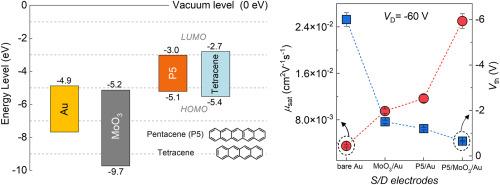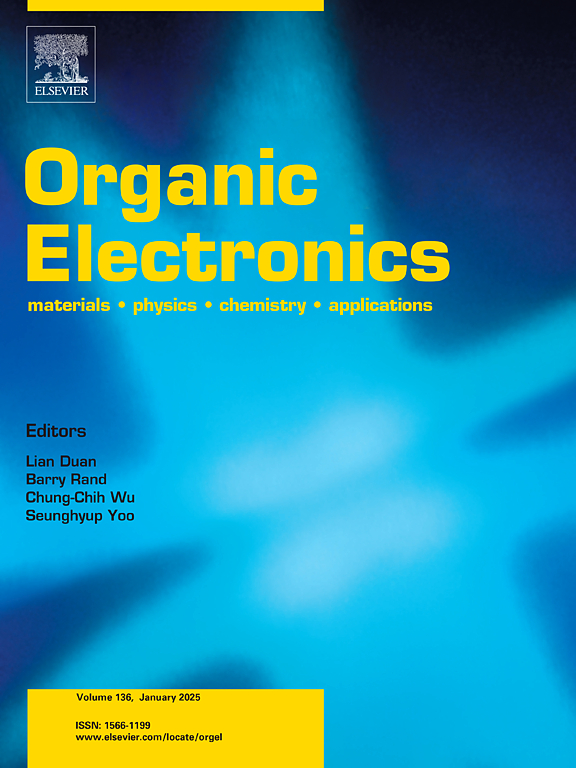用于有机晶体管高效电荷注入的有机-无机杂化注入层
IF 2.6
4区 工程技术
Q3 MATERIALS SCIENCE, MULTIDISCIPLINARY
引用次数: 0
摘要
探索合适的注入层结构,无论是简单的还是混合的有机-无机双层,都能保证高效的电荷注入,良好的界面性能和低成本的制造,对于推进无机和有机电子器件的发展具有重要的技术意义。在本研究中,制备了一系列基于四烯的有机薄膜晶体管(tetracene-OTFTs),并对其进行了表征和系统研究,包括具有裸Au源/漏极(S/D)的参考器件,以及在Au S/D电极下包含MoO3,并五苯(P5)和混合P5/MoO3双层的器件。在所有配置中,采用P5/MoO3注入双分子层的器件表现出最高的性能,实现了2.5 × 10−2 cm2 V−1 s−1的空穴迁移率,降低了- 0.65 V的阈值电压,接近零的起始电压,高的开/关电流比为5.6 × 104,低的接触电阻为1.2 × 103 kΩ,并且降低了陷阱密度。杂化P5/MoO3注入双分子层对器件电性能的增强是由于其协同作用:MoO3为高效的空穴注入提供了有利的能级排列,而超薄的P5层作为扩散屏障,形成了相干的有机/有机界面,增强了与四烯活性层的形态相容性。这些发现突出了混合注入双层结构在同时优化电荷注入、界面能量学和器件性能方面的巨大潜力,从而为下一代高性能混合电子器件铺平了道路。本文章由计算机程序翻译,如有差异,请以英文原文为准。

Organic–inorganic hybrid injection layers for efficient charge injection in organic transistors
Exploring suitable injection layer architectures, whether simple or hybrid organic–inorganic bilayers, that ensure efficient charge injection, favorable interfacial properties, and low-cost fabrication is of great technological significance for advancing inorganic and organic electronic devices. In this study, a series of tetracene-based organic thin-film transistors (tetracene-OTFTs) were fabricated, characterized, and systematically investigated, including reference devices with bare Au source/drain (S/D) electrodes and devices incorporating injection layers such as MoO3, pentacene (P5), and a hybrid P5/MoO3 bilayer beneath the Au S/D electrodes. Among all configurations, devices employing the P5/MoO3 injection bilayer demonstrated the highest performance, achieving a hole mobility of 2.5 × 10−2 cm2 V−1 s−1, a reduced threshold voltage of −0.65 V, near-zero onset voltage, a high on/off current ratio of 5.6 × 104, a low contact resistance of 1.2 × 103 kΩ, and reduced trap densities. The enhanced electrical performance of devices with the hybrid P5/MoO3 injection bilayer is attributed to its synergistic function: MoO3 enables favorable energy level alignment for efficient hole injection, while the ultrathin P5 layer acts as a diffusion barrier and forms a coherent organic/organic interface that enhances morphological compatibility with the tetracene active layer. These findings highlight the significant potential of hybrid injection bilayer architectures to simultaneously optimize charge injection, interfacial energetics, and device performance, thereby paving the way toward next-generation high-performance hybrid electronic devices.
求助全文
通过发布文献求助,成功后即可免费获取论文全文。
去求助
来源期刊

Organic Electronics
工程技术-材料科学:综合
CiteScore
6.60
自引率
6.20%
发文量
238
审稿时长
44 days
期刊介绍:
Organic Electronics is a journal whose primary interdisciplinary focus is on materials and phenomena related to organic devices such as light emitting diodes, thin film transistors, photovoltaic cells, sensors, memories, etc.
Papers suitable for publication in this journal cover such topics as photoconductive and electronic properties of organic materials, thin film structures and characterization in the context of organic devices, charge and exciton transport, organic electronic and optoelectronic devices.
 求助内容:
求助内容: 应助结果提醒方式:
应助结果提醒方式:


